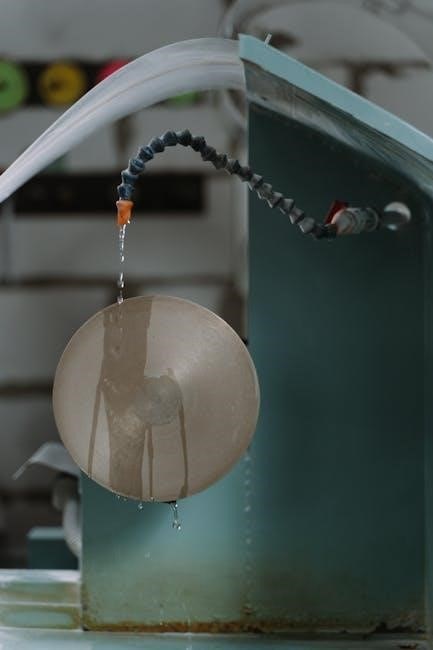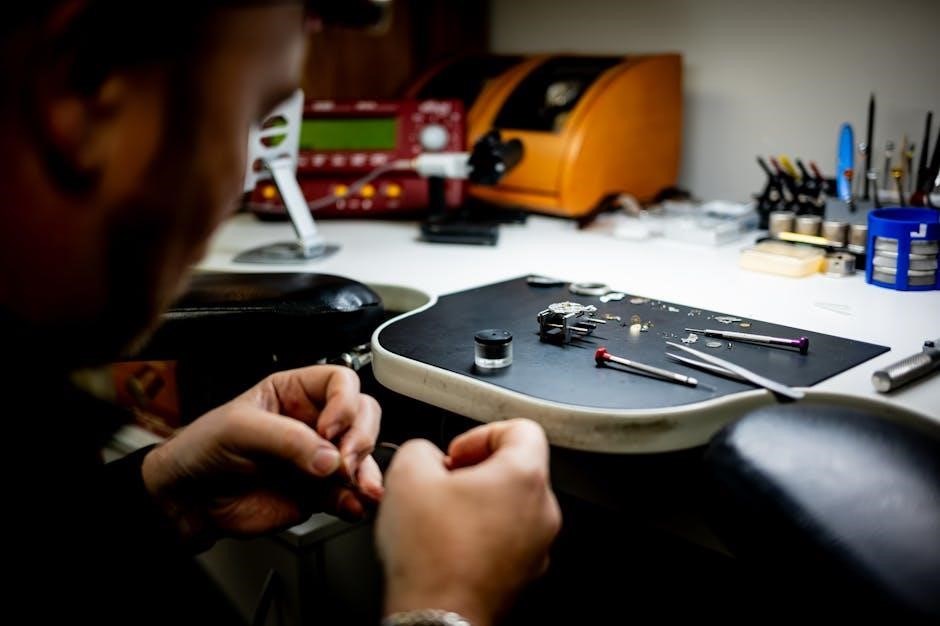Microscopy is the science of exploring microscopic structures, providing a magnified view of tiny details. It’s a vital tool in biology, chemistry, and medicine, enabling discoveries at the cellular level.
Overview of Microscopy and Its Importance
Microscopy is a fundamental scientific tool that enables the visualization of objects too small to be seen with the naked eye. It plays a crucial role in various fields, including biology, medicine, chemistry, and materials science. By magnifying microscopic structures, microscopes help scientists understand cellular details, diagnose diseases, and analyze materials. The importance of microscopy lies in its ability to reveal the invisible, fostering breakthroughs in research and education. It allows for the study of microorganisms, tissues, and molecular structures, contributing to advancements in medical treatments and technological innovations. Furthermore, microscopy aids in quality control and forensic investigations, making it an indispensable instrument in both academic and industrial settings. Its significance extends to education, where it inspires curiosity and learning about the microscopic world.
Key Components of a Microscope
A microscope consists of essential parts like the eyepiece, objective lenses, revolving nosepiece, stage, and illumination system. These components work together to magnify and focus light for clear observation of specimens.

Eyepiece (Ocular Lens)
The eyepiece, or ocular lens, is the lens through which you look to view the specimen. It magnifies the image produced by the objective lens, typically offering a standard magnification power of 10x. This lens is crucial for focusing the image and adjusting it to suit the observer’s vision. Proper alignment and cleanliness of the eyepiece ensure clear and accurate observation. Together with the objective lens, it forms the compound microscope’s optical system, enabling detailed visualization of microscopic structures.
Objective Lenses
Objective lenses are a critical component of a microscope, located near the specimen and responsible for the initial magnification of the image. They are available in different magnification powers, such as 4x, 10x, 40x, and 100x, with higher magnification lenses used for more detailed observations. Each objective lens is designed to focus light from the specimen onto the eyepiece, creating a real and inverted image. The choice of objective lens depends on the desired level of detail and the type of specimen being examined. Higher magnification objectives often require oil immersion to enhance resolution. The objective lenses are typically mounted on a revolving nosepiece, allowing easy switching between different magnifications. Proper alignment and focus of the objective lens are essential for obtaining clear and accurate images. Regular cleaning and maintenance of these lenses are necessary to ensure optimal performance and longevity. They are indispensable for achieving precise and detailed microscopic observations.
Revolving Nosepiece
The revolving nosepiece is a circular platform located below the body tube of the microscope, designed to hold multiple objective lenses. Its primary function is to allow quick and easy switching between different magnification powers by rotating the nosepiece. Typically, it can accommodate three to four objective lenses, each with varying magnification strengths. The nosepiece is spring-loaded to ensure secure holding of the lenses, preventing any movement during observation. Proper alignment of the objective lenses with the light source is crucial for clear imaging. The revolving mechanism simplifies the process of changing magnifications without altering the focus significantly. Regular cleaning and maintenance of the nosepiece are essential to ensure smooth operation. It is an integral part of the microscope’s optical system, enabling efficient and precise observations. The revolving nosepiece is a fundamental component that enhances the versatility and functionality of the microscope.
Mechanical and Structural Parts
The mechanical parts include the stage, which holds the specimen, stage clips for securing it, the arm connecting to the base and supporting the tube, and the base for stability, ensuring proper alignment and support for the microscope’s operation.
Stage and Stage Clips
The stage is a flat platform where the specimen is placed for observation. It is typically made of metal or plastic and is positioned beneath the objective lens. Some microscopes feature a movable stage, allowing for precise adjustment of the specimen’s position. Stage clips are metal or plastic holders attached to the stage to secure the slide in place. These clips ensure the specimen remains steady during observation, preventing movement that could blur the image. The stage is often equipped with a mechanical stage control, enabling users to move the slide smoothly in both the x and y directions. This feature is particularly useful for examining large specimens or detailed sections of the sample. Proper use of the stage and stage clips is essential for achieving clear and accurate microscopic observations.
Arm and Base
The arm and base are essential structural components of a microscope, providing stability and support for the entire instrument. The base is the foundation of the microscope, typically made of heavy, durable material to prevent wobbling or movement during use. It houses the light source and connects to the arm, which extends upward to support the rest of the microscope. The arm acts as a bridge, connecting the base to the body tube, stage, and other optical components. Its sturdy design ensures the alignment and balance of the microscope, allowing for smooth operation and precise observations. Together, the arm and base form the framework that holds all other parts in place, ensuring the microscope functions efficiently and maintains optical clarity. Proper care of these components is crucial to prolonging the lifespan and performance of the microscope.

Illumination and Focus Adjustments

Illumination systems, including the light source and diaphragm, provide the necessary light for viewing samples. Coarse and fine adjustment knobs enable precise focusing, optimizing image clarity and detail at varying magnifications.
Light Source and Diaphragm
The light source is a critical component of a microscope, typically using a built-in LED or halogen bulb to illuminate the specimen. This ensures even light distribution for clear observation. The diaphragm, located beneath the stage, regulates the amount of light entering the microscope by adjusting its aperture. It helps in optimizing contrast and reducing glare, enhancing image quality. Proper alignment and adjustment of these elements are essential for achieving sharp, well-lit images. The diaphragm also includes different sized holes to match various objective lenses, ensuring optimal light intensity. Together, the light source and diaphragm work harmoniously to provide the ideal illumination setup for microscopic examinations, making them indispensable for accurate observations in scientific and educational settings. Their synchronized functioning ensures that users can focus on specimen details without distractions from excess light or insufficient illumination. Effective use of these components is fundamental for maximizing the microscope’s performance.
Coarse and Fine Adjustment Knobs
The coarse adjustment knob is used to rapidly focus the image by moving the stage up or down. It is typically used at lower magnifications to bring the specimen into approximate focus. The fine adjustment knob, on the other hand, allows for precise focusing by making smaller, more delicate adjustments. This knob is essential for achieving sharp, high-resolution images, especially at higher magnifications. Together, these knobs enable users to accurately position the specimen in the focal plane of the objective lens. The coarse adjustment is often used initially to find the general focus, while the fine adjustment is employed to refine the image, ensuring clarity and detail. Proper use of these knobs is crucial for effective microscopy, as incorrect adjustments can lead to blurry images or damage to the microscope components. Their synchronized operation ensures that users can effortlessly transition between magnifications while maintaining a focused view of the specimen.

Additional Features and Accessories
Modern microscopes often include accessories like specialized illumination systems, camera adapters, and ergonomic stages. Additional features may involve advanced imaging software, focus aids, or interchangeable eyepieces for enhanced functionality.
Body Tube and Optical Path
The body tube acts as the housing for the optical components, ensuring proper alignment and light transmission between the eyepiece and objective lenses. It contains the internal optical path, which directs light from the specimen through the lenses for magnification. The body tube’s design is critical for maintaining image clarity and focus. Modern microscopes often feature interchangeable body tubes or light paths to accommodate different imaging techniques, such as fluorescence or polarized light microscopy. Proper alignment of the optical path is essential for achieving high-resolution images. Accessories like tube lengths and adapters can customize the microscope for specific applications, enhancing its versatility in various scientific fields.